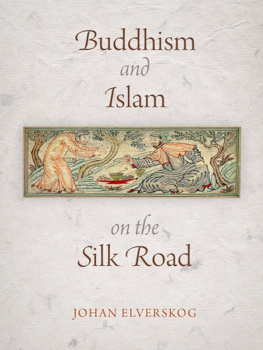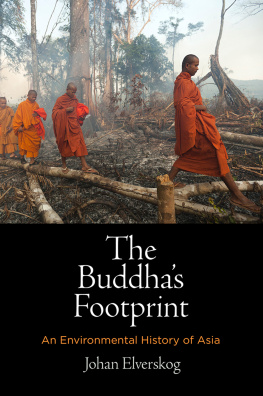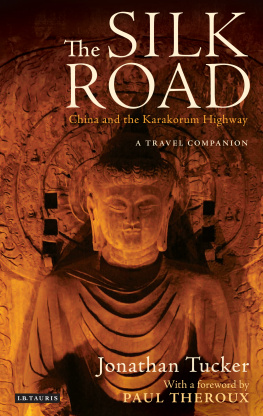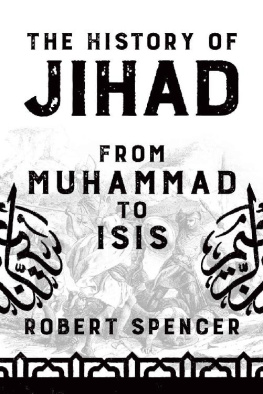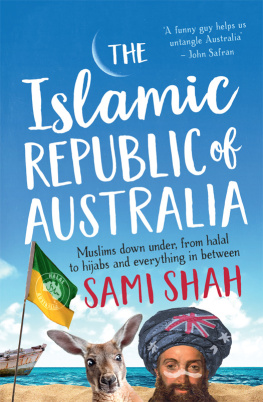Elverskog - Buddhism & Islam on the Silk Road
Here you can read online Elverskog - Buddhism & Islam on the Silk Road full text of the book (entire story) in english for free. Download pdf and epub, get meaning, cover and reviews about this ebook. City: Asia;Singapore, year: 2013, publisher: University of Pennsylvania Press, Inc.;Institute of Southeast Asian Studies, genre: Religion. Description of the work, (preface) as well as reviews are available. Best literature library LitArk.com created for fans of good reading and offers a wide selection of genres:
Romance novel
Science fiction
Adventure
Detective
Science
History
Home and family
Prose
Art
Politics
Computer
Non-fiction
Religion
Business
Children
Humor
Choose a favorite category and find really read worthwhile books. Enjoy immersion in the world of imagination, feel the emotions of the characters or learn something new for yourself, make an fascinating discovery.
Buddhism & Islam on the Silk Road: summary, description and annotation
We offer to read an annotation, description, summary or preface (depends on what the author of the book "Buddhism & Islam on the Silk Road" wrote himself). If you haven't found the necessary information about the book — write in the comments, we will try to find it.
Buddhism & Islam on the Silk Road — read online for free the complete book (whole text) full work
Below is the text of the book, divided by pages. System saving the place of the last page read, allows you to conveniently read the book "Buddhism & Islam on the Silk Road" online for free, without having to search again every time where you left off. Put a bookmark, and you can go to the page where you finished reading at any time.
Font size:
Interval:
Bookmark:
ACKNOWLEDGMENTS

D URING THE WRITING of this book I attended the seminar of a noted Polish sociologist who, during his lecture, chided American scholars for thanking their families in their acknowledgments. For him this was slightly ridiculous. Instead he advocated that one should thank those scholars found in the bibliography.
While I sympathize with this sentiment, I nevertheless begin by thanking my wife, Liljana, who on short notice allowed to me to turn our family life upside-down, so that I, with our son in tow, could head off to Sweden and set about writing this book. Without her unflagging support and understanding, writing these pages would never have been possible.
Heading off to Sweden, of course, was not simply done on a whim. Rather, I was fortuitously invited to join a group of scholars working on Inner Asia at the Swedish Collegium for Advanced Study, and for this I deeply thank Barbro Klein, Staffan Rosn, and Bjrn Wittrock. Indeed, without the respite from teaching and everyday academic work that this opportunity afforded it is unlikely that this project could ever have been attempted. For creating and maintaining such a scholar's utopia, I therefore wish to thank the directors and staff at SCAS for making my stay in Uppsala so enjoyable and productive.
At the same time it should also be noted that the manuscript I wrote in the hallowed halls of the Linneanum had its origins back in my teenage years when I was enthralled by the writers of the Beat Generation and came across Brion Gysin's early mixing of Arabic and Chinese calligraphy. Of course, how this youthful curiosity blossomed into this book is a long story. Yet it is one that could not have happened without the guidance and support of all the teachers I have had the good fortune to work with at the University of California, Berkeley, the Naropa Institute, the Karmapa Institute, Tribhuvan University, Middlebury College, and Indiana University, Bloomington. Without having had the good fortune to meet all of these teachers I would never have had the intellectual wherewithal to try to bring my childhood fantasies to academic reality.
Forging this reality, however, was not a solo affair. Numerous colleagues have helped me think about and shape my argument through discussions and the endless emailing of various queries, and I thank them all, but I especially want to thank those who offered valuable comments on earlier drafts of this work: Thomas Allsen, Chris Atwood, Brian Baumann, Devin DeWeese, Ayman El-Desouky, Philippe Fort, Kim Hodong, Victor Mair, Aleksandr Naymark, Morris Rossabi, Bruce Tindall, Gray Tuttle, Dan Waugh, and Abdurishid Yakup.
Portions of this work were also presented at various conferences, and colloquia, and I wish to thank everyone who invited me, and to those who provided helpful comments and criticisms during my presentations at the Warburg Institute, Uppsala University, Rice University, the University of Toronto, McMaster University, the University of Southern California, and Harvard University.
I also want to thank all those who helped with the images and maps found throughout the book: Helen Abbott, Ian Aberle, Rudolph Abraham, Rodney Ast, Norman Belza, Jonathan Bloom, Geoff Childs, Michael Crow, Karl Debrecezny, Melvyn Goldstein, Amy Hofland, Linda Komaroff, Donald LaRocca, Angelo Lui, Auste Mickunaite, Maggie Murphy, Jennifer Lee, Ruth Long, Sandra Powlette, Jane Siegel, Eric Sommer, Volker Thewalt, Johannes Thomann, Jade Tran, Jenna Turner, Lynda Unchern, Sinad Ward, Doris Weiner, and Shiyuan Yuan. Moreover, I wish to thank James Quick of the Office of Research and Graduate Studies at Southern Methodist University, as well as Dean Peter Moore, for providing funds to help defray the cost of reproducing these images.
Last, I want to thank everyone involved in the actual creation of this book beginning with Victor Mair, who quite literally took my manuscript under his wing as he was heading out the door. Since then he has been a constant source of encouragement and sage advice. I also thank Peter Agree and the staff at Penn Press, especially Ashley Nelson, Noreen O'Connor-Abel, Jennifer Malloy, and Sandra Haviland, for making the final stretch of this project such a joy.
And finally, I want to thank all of the scholars whose work is cited in the notes. Without their pioneering work this project could not have been brought to fruition.
CHAPTER ONE

O ye who believe! Eat not up your property among yourselves in vanities: but let there be amongst you traffic and trade by mutual good-will.
Quran 4:29
The wise man trained and disciplined
Shines out like a beacon-fire.
He gathers wealth just as a bee
Gathers honey, and it grows.
Like an ant-hill higher yet.
With wealth so gained the layman can
Devote it to his people's good.
He should divide his wealth in four.
One part he may enjoy at will,
Two parts he should put to work,
The fourth he should set aside,
A reserve in times of need.
Siglaka Sutta, Dgha Nikya
A BUDDHIST STUDIES JOKE has it that the Dharma in the West should not be called the Middle Way, but the Upper Middle Way. The joke, of course, lies in the contradiction between the image of a Buddhist monk who has renounced all worldly possessions and the pampered, jet-set Buddhist. Yet is there really such a contradiction between being both Buddhist and wealthy?
If one looks at the question historically the answer is no. From the very beginning and throughout the millennia it has always been the rich and powerful who have kept the Dharma in business. For some this may seem incongruous. Wealth, power, and violence are the very things Buddhism supposedly rejects. Indeed, it is this absence that most often sets the Dharma apart in the contemporary religious marketplace. Buddhism is namely the one tradition that seemingly transcends all the things that generally give religion a bad name. Yet, as noted in the introduction, this view of Buddhism is a selective reading of Buddhist doctrine and history.
Thus if one were so inclined it would be very easy to dredge up the seamier underbelly of the Dharma. For example, one can readily point out Buddhism's misogyny.
[Of those in] the band of enemies who have despoiled the duties entrusted to them:
Make the male lines like trees that have had their roots cut;
Make the female lines like brooks that have dried up in winter;
Make the children and grandchildren like eggs smashed against rocks;
Make the servants and followers like heaps of grass consumed by fire;
Make their dominion like a lamp whose oil has been exhausted;
In short, annihilate any traces of them, even their names.
To find such Kurtzean images connected with the Dalai Lama may be jarring to some; however, the fact of the matter is that Tibetan history accords less with the popular Western image of Shangri-La and more with the religious chaos and violence of Reformation and post-Reformation Europe.
Thus contrary to the popular understanding Buddhism is not innately above and beyond the horrors found in the other world religions. In fact precisely for this reason scholars have in recent years reveled in exposing some of these less-than-savory aspects of the Dharma. But this scholarship has not had much of a trickle-down effect on popular perceptions. Buddhism still retains its aura of being as pure as the driven snow. Whether this is true or not, however, is not the point to be argued here. Rather, the point is simply to reveal how the popular vision of the Dharma potentially shapes or distorts the story of what happened when Buddhism came into contact with Islam.
Next pageFont size:
Interval:
Bookmark:
Similar books «Buddhism & Islam on the Silk Road»
Look at similar books to Buddhism & Islam on the Silk Road. We have selected literature similar in name and meaning in the hope of providing readers with more options to find new, interesting, not yet read works.
Discussion, reviews of the book Buddhism & Islam on the Silk Road and just readers' own opinions. Leave your comments, write what you think about the work, its meaning or the main characters. Specify what exactly you liked and what you didn't like, and why you think so.

